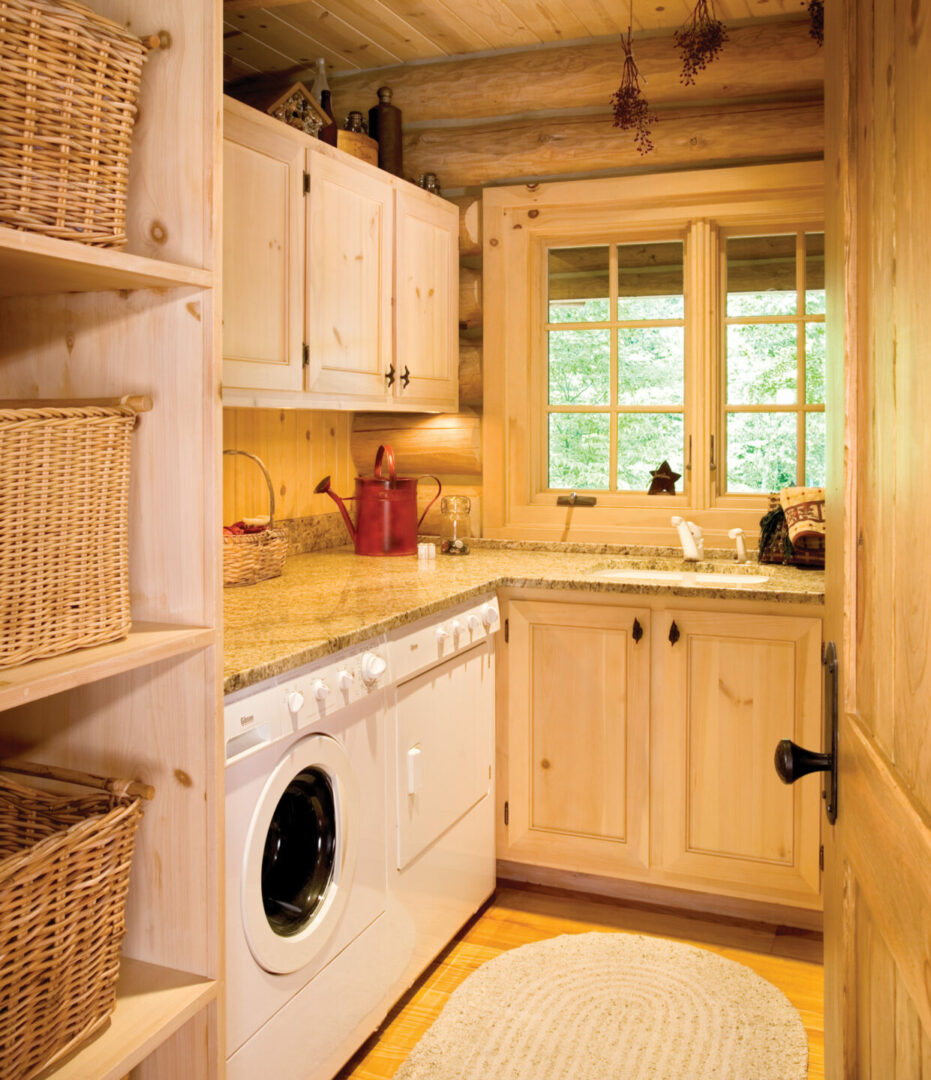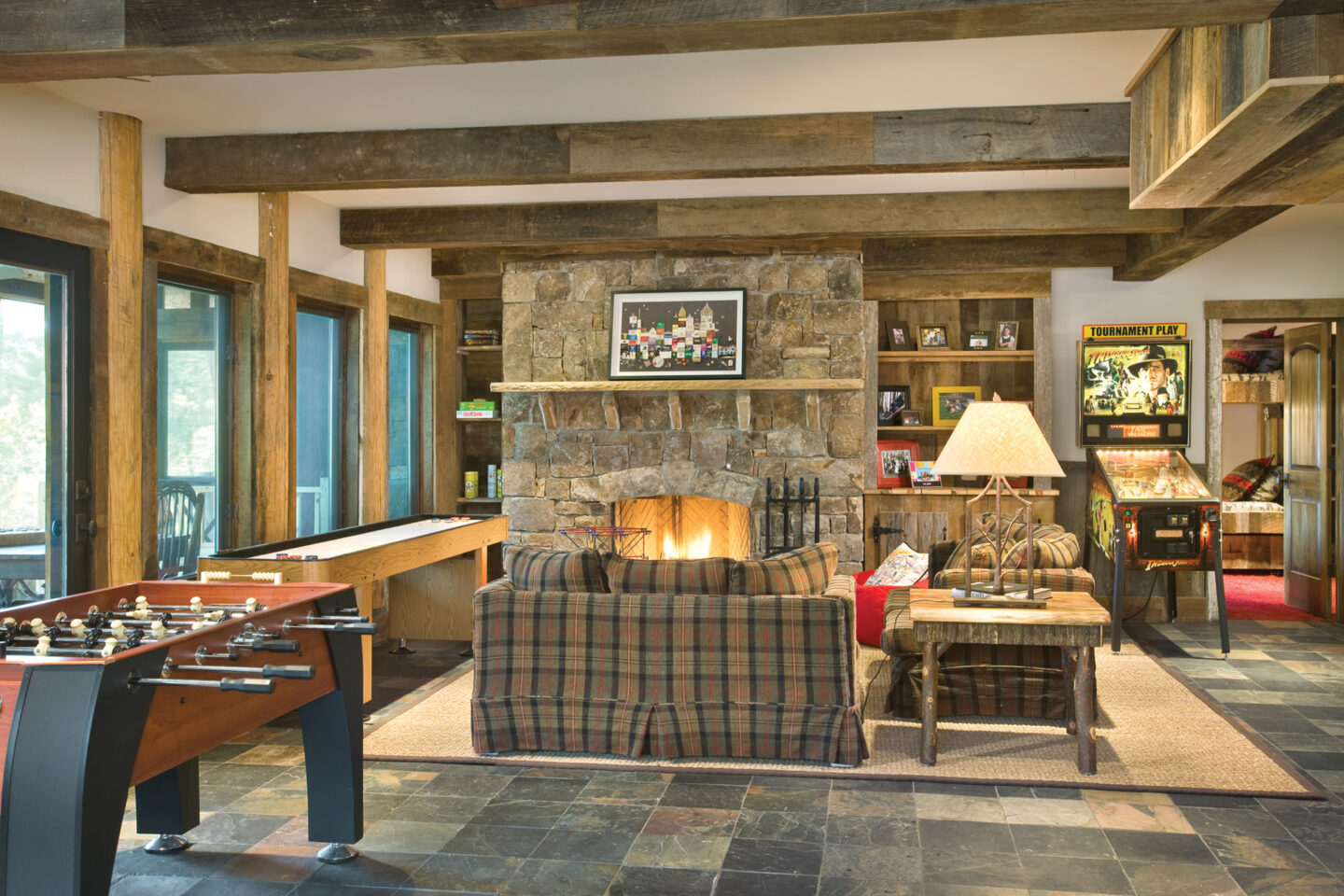There are many small but important things to consider before building your home.
Overlooking little details when building a home can become nuisances once you live in your beautiful new home. Creating a list of little things that are ultimately important to your everyday life and reviewing it with your building team (architect, log or timber home producer, builder, etc.) can make a huge difference in your enjoyment of your new home. Log and timber home experts recommend thinking about these 40 things before you build:
Storage
Consider storage needs for each room—kitchen, bedrooms, laundry, garage. Make a list of the storage you currently need and think about where to add or subtract. “You have everyday storage needs such as clothing, and pantry items, but you also need to consider seasonal items to store. Where will you put decorations, garden supplies, seasonal clothing and hobbies.” (Mark Elliott, Coventry Log Homes)
“Basements are the best place to get extra storage. You can also use the space under staircases, and loft areas where the roofline meets the floor system can be enclosed to give some nice storage areas.” (Robert Lockerby, Summit Handcrafted Log Homes)
Don’t underestimate how much storage you’ll need for linens, especially if you have multiple bedrooms and bathrooms. Consider a large linen closet or extra storage in your laundry room. 
Electrical
Consider alternate design options for your living room and prewire so you can easily move your TV if you want to rearrange the room. “It seems like the TV is the focal point of most living rooms and if you ever want to move furniture around you might want to plan ahead.” (Mark Elliott, Coventry Log Homes)
Plan for where you may want to put your Christmas tree and be sure you have an outlet nearby.
Place electrical outlets in the floor if you will have any floating furniture groupings (like in the middle of a great room) so you can plug in lamps, phone chargers, etc. (Erwin Loveland, MossCreek)
Don’t wait until later to identify all the circuits in your power panel box. Your electrician should identify the circuits before they leave! Plumbing
Put shut-off valves in the plumbing runs for every fixture. “The additional cost is minimal, and it helps to further isolate leaks or broken plumbing fixtures. And it saves you from having to shut off water to the entire house to fix one fixture.” (Erwin Loveland)
Be sure to not block off the main water shut-off for the house!
If you have pets, consider putting a dog wash/mop sink in your laundry or mud room. It’s much easier for bathing, and it eliminates the need to lift them into your own tub!Accessibility
Plan for a flush entryway to make your home more accessible. “Removing steps from entryways may be one of the most important elements of accessible design but is often overlooked because it requires specific attention to the design of the foundation system, from the beginning.” (Troy Stokes, Designer, Riverbend Timber Framing)
While you may not need grab bars or rails in bathrooms when you first build your home, it’s a good idea to put in the blocking for them to screw into when you do your wall framing. Take note of where the blocks are so it will be easier when you have to install grab bars or rails later.
Handrails on both sides of a staircase can be helpful as you age.
Install appliances like ovens and dishwashers at waist height, to reduce the need for bending. Kitchen
Conceal electrical outlets under your upper cabinets.Make smart use of all available storage space.
Include one lower 24-30” wide cabinet with vertical slots for baking sheets.
Lower drawers on full-extension heavy-duty tracks are the most practical option for pots and pans.
Don’t forget to add electrical outlets to your kitchen island. A small sink is also handy if your island will be your primary workspace for cooking.
Lighting in the kitchen should be varied and functional—under-cabinet lighting is a must-have! Bathrooms
Hide electrical outlets in your vanity cabinets.
Radiant in-floor heating systems are efficient and wonderful in bathrooms or areas of your home that might be colder.
A skylight in the bathroom brings in natural light without sacrificing privacy. Basements
If you will be adding living space in your basement, make sure you have adequate room for the ceiling heights you want—this may mean digging a deeper foundation. An 8’ ceiling (or higher) can make a basement feel more spacious and open.
Even if you aren’t planning to finish the basement when you build, consider having your plumbing and electrical systems roughed in so finishing later will be easy. Bedrooms
Consider where children or teenagers will play or hang out and insulate the walls of those •Extra insulation between the master bedroom and adjacent rooms will help dampen sound from the laundry room (washer/dryer) or kitchen (dishwasher).
If you will have a TV in your bedroom, pre-wire for it on the wall where you plan to hang it. Mudroom/Laundry room
Use flooring, cabinetry and wall coverings in your mudroom that are durable and won’t show dents and dings.
Luxury vinyl is a durable flooring option for high-traffic areas that still looks and feels high-end.
The laundry room should be close to where the linens and clothes are stored to save yourself from hauling laundry up and down stairs.
Mudrooms are a great place for built-in storage—sports equipment, boots, seasonal clothing and gear can all be stored in your mudroom. This is also a good place for seating—perhaps a bench with storage beneath? Outdoors
If you have outside water connections, consider having an inside shut-off for them as well.
If you have pets, hot and cold water outside is useful for rinsing off muddy paws.
A covered entryway doesn’t just protect you from the elements, it can also make your home feel more welcoming—but it can block light. Add windows around your door in the door itself to reclaim some of that sunlight.
Map any sewer/power/water connections before final landscaping is done. If you have a septic system, note the tank and drain field locations.
Plan electrical outlets under your eaves for Christmas lights—or outdoor lights any time of year.
Plan lighting along outdoor pathways and along outdoor stair treads to avoid outdoor falls.
Place a drain in the garage to get rid of water from your vehicles after a snowfall or rainstorm. 
